Goose cinquefoil (P. anserina)
A striking representative of the genus is the cinquefoil goose. It is a ground cover plant that is easy to find along fences, on country roadsides, in meadows and near waterways. Due to the ability to reproduce with a mustache, the culture received the nickname "caterpillar" among the people. Due to its unpretentiousness, it is worth the Potentilla to get into more or less favorable conditions, after a few years its recognizable feathery leaves and bright yellow flowers appear on the entire site.
The ornamental plant is widespread in Russia and is even used as an ornamental crop. Potentilla with yellow flowers and bright green foliage acquires particular value where, due to high air pollution, other species do not take root.
Nepalese cinquefoil (P. nepalensis)
The era of geographical discoveries brought humanity not only acquaintance with new lands, but also with previously unknown representatives of the green world. Nepalese cinquefoil, which grows naturally in the western part of the Himalayas, interested botanists and gardeners:
- unusually large palm leaves;
- collected in sparse inflorescences of pink or fireplace-red flowers up to 30 mm in diameter;
- shoots, like corollas, have anthocyanin coloration;
- flowering lasting up to 55 days.
Since 1820, the plant has been cultivated as an ornamental crop. On the basis of the wild-growing variety, scientists have obtained large-flowered varieties that are as unpretentious and willingly blooming as their ancestors from Asia.
An example is Miss Wilmott's cinquefoil, with its bold pink flowers, with a dark cherry-colored eye and a web of veins radiating from the center of each petal.
See also: What vitamins are in apples and how they are useful
Types and varieties
Potentilla has been cultivated from about the beginning of the 18th century. Initially, the shrub was wild, but to date, at least 130 different varieties of this plant of various shapes, heights, colors of flowers and leaves have been bred. Some varieties can be grown in conditions close to permafrost, others prefer a warm climate, bloom only in the south. Pink Quinck, Abbotswood, Red Ace are considered popular.
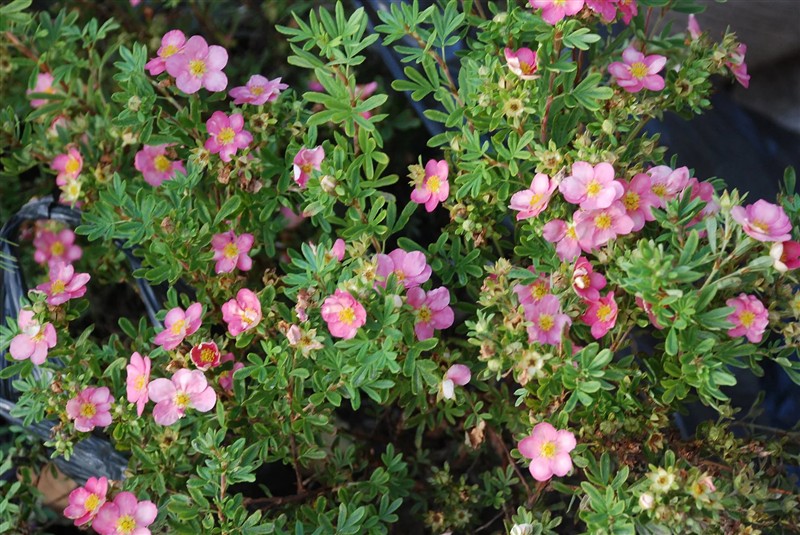
Princess Variety
Abbotswood
Deciduous shrub 1 m high. The crown is wide, semicircular. Abundant flowering, several hundred snow-white flowers appear on each bush. Flowering is long, some flowers bloom even in October, if the month is warm. Leaves are yellowish-green elongated, up to 2.5-3 cm in length.
This variety of Potentilla tolerates drought well. It should be planted in a well-lit area or in partial shade. The soil should be moist, but not swampy; drainage must be laid at the bottom of the planting pit.
Important! A young plant quickly gains in growth, to approach flowering, Potentilla is fed with mineral fertilizers
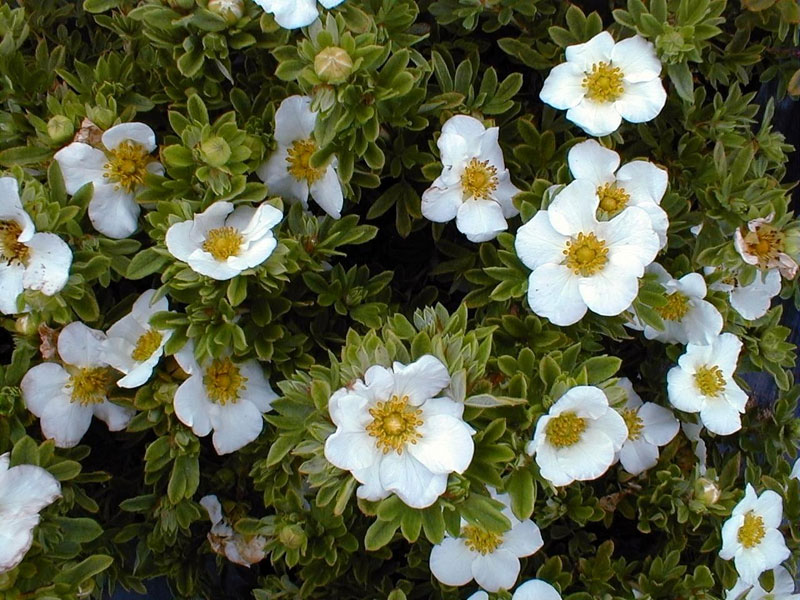
Guildford Cream
Guildford Kirm
Tall shrub with bright green leaves. The average height is 1.2-1.5 m, the size of the rounded crown is 0.8-1 m. In the northern strip, it blooms in July. In the south, flowering begins in May and lasts until September. The flowers are large creamy white with a diameter of up to 3 cm. Guildford Kirm's cinquefoil is undemanding to the growing conditions. The main thing is not to overmoisten the soil and often water the plant during a drought, avoiding the appearance of cracks in the ground.
For your information! This type of shrub is light-requiring, but it can be planted in partial shade. It tolerates winter well. In the fall, he drops all the leaves.
Red Ace
Low shrub, up to 0.50-65 cm in height.To creep along the ground, the crown is extensive, covers an area equal to 1.2 m. The leaves are light green with a silvery tint. Blooms in spring, late April or May. Shoots are mostly creeping. The peeling bark is colored red, reddish brown or gray.
Red Ace loves swampy soils and partial shade. Frost resistance in this variety of Potentilla is high. The plant needs regular pruning. It can be used in any garden area.
Important! A feature of the Red Ace variety is the change in the shade of the buds during the flowering process. Spring flowers are orange or red, summer orange with a predominance of yellow
The duration and timing of flowering depends on the region.
Hoppy Orange
Small shrub no more than 0.5 m high. Creeping branches, large flowers, up to 5 cm in diameter. The color of the buds is orange. The plant blooms all summer and most of autumn.
You need to plant in partial shade. If the flowers are exposed to direct sunlight, they fade, the appearance of the plant becomes less attractive. Grows on loose and moist soils. The soil should be sandy loam or loamy, acidic. The alkaline composition of the soil is also important (the brightness of the buds depends on it), if necessary, it is changed artificially. If the amount of alkali in the soil is exceeded, the leaves of Potentilla turn yellow.
Description and varieties
Cinquefoil belongs to the genus of the Pink family. There are annual and perennial species of this plant, which can be a herbaceous culture or small shrubs. Under natural conditions, Potentilla grows in Siberia, Western Europe, the Far East, China and the Altai mountains. Flowering plantations, which are used in horticulture, are bred by breeders and are hybrids of wild species.
Appearance and features
The ornamental shrub has the shape of a ball and reaches a diameter of 100 to 120 cm. The height of the plant usually does not exceed 1.5 meters. The branches are very dense and completely covered with cone-shaped foliage with a velvet surface. The leaves consist of five plates and have a rather rich green color, which becomes emerald-silver with the onset of cold weather. Flower growers appreciate Potentilla very much for its ability to branch strongly and grow rapidly, abundantly covered with bright buds.
The flowering of the plant begins in June and lasts until the end of September. Flowers can be arranged individually or collected in lush inflorescences. During this period, the planting is almost completely covered with bright colors and looks very beautiful and attractive. Large buds from 4 to 6 cm are red, yellowish-burgundy, white, pink and can visually turn a bush into one large flower with their number. Wild varieties are mainly yellow-orange in color of inflorescences.
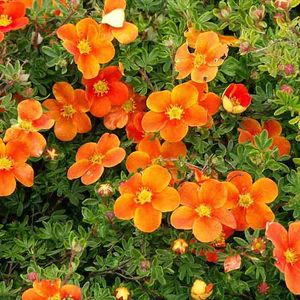 In autumn, the plant produces fruits with crescent-shaped seeds, which look very beautiful against the background of yellowing foliage. After that, the bush begins to prepare for winter and gradually sheds its leaves.
In autumn, the plant produces fruits with crescent-shaped seeds, which look very beautiful against the background of yellowing foliage. After that, the bush begins to prepare for winter and gradually sheds its leaves.
Cinquefoil is also called cinquefoil, dazifora, and Kuril tea, since decoctions based on young leaves have a hemostatic, expectorant, bactericidal and choleretic effect. They also improve the functioning of the gastrointestinal tract, strengthen the immune system. The plant can also be used for external use in the treatment of burns, wounds, inflammation of the skin.
Popular plant varieties
Ornamental planting can belong to different types, which differ in the size and height of the bushes, the color of the inflorescences and foliage. In total, there are about 15 varieties of Potentilla shrub, but the most famous and demanded of them are:
- Hoppy Orange. The plant reaches a height of 50 cm, the diameter of the crown is 100 cm. Its foliage is green, the inflorescences are colored orange-yellow.The ornamental plantation has good frost resistance and endurance, therefore it is often preferred to grow by owners of summer cottages and private houses.
- Abbotswood. The length of the bush is 90 cm, the width of the crown is about 120 cm. Light green leaves are located quite densely on the branches, white buds are collected in small groups. This type of Potentilla is one of the best, it looks great in group and single plantings, being a worthy decoration for any garden.
- Red Robbin. The planting is 65-70 cm high, with a crown diameter reaching 130 cm. Branched shoots have bright green leaves and burgundy flowers with a yellow center. The flowering of the plant begins in mid-summer and continues until the end of autumn.
- Catherine Dykes. The spreading bush can grow up to 120 cm. It has a lush crown with gray-green foliage and large light beige flowers. This variety of Potentilla has an exquisite, delicate appearance and is characterized by a long flowering.
- Red Ace. In a plant of this species, shoots spread along the ground, its height is 65-75 cm, the width of the upper part is about 1.2 meters. The leaves are juicy, green in color, the buds are red-orange, very bright and beautiful.
Canna: botanical description, features of planting and flower care
Today, many varieties of winter-hardy Potentilla have been bred, so residents of the northern regions should pay attention to them when buying plants. It should also be borne in mind that bushes with white and yellow flowers prefer sunlight.
Such plantings are easier to care for, since they do not require a special soil composition and frequent watering, unlike plants with red and pink flowers.
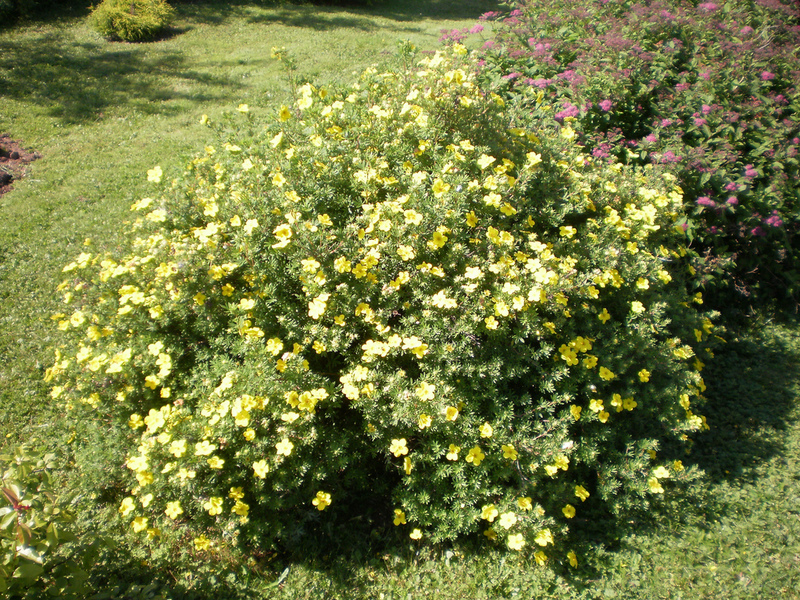

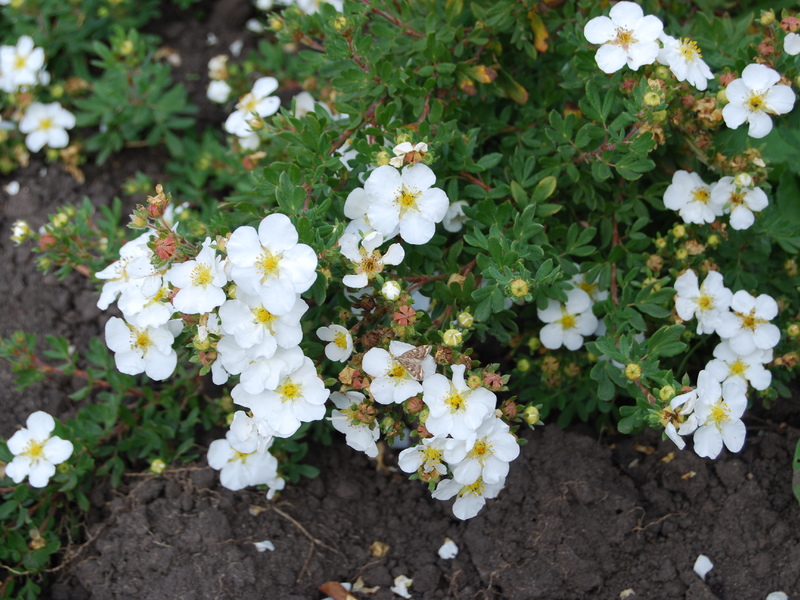
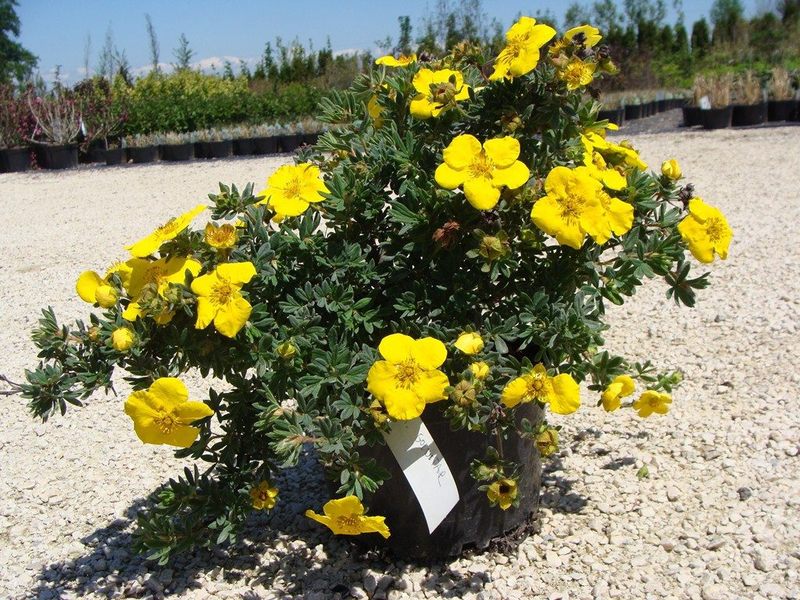
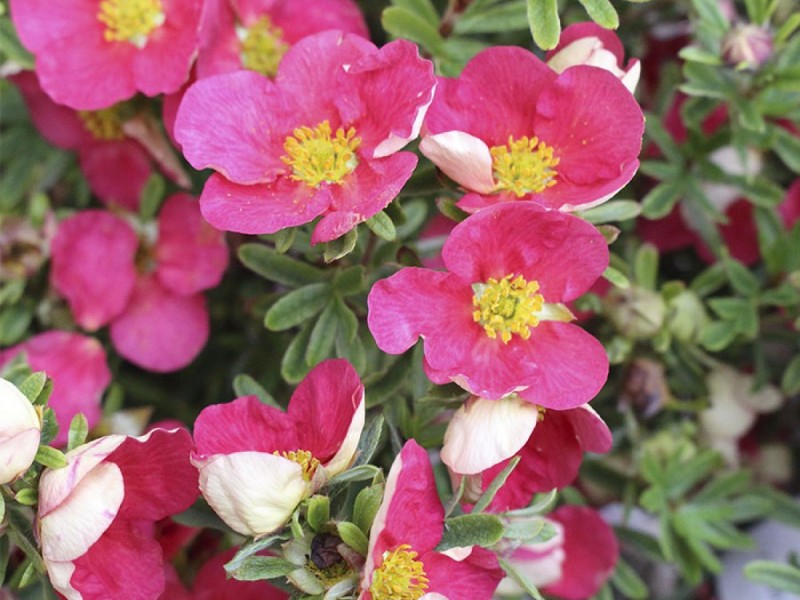
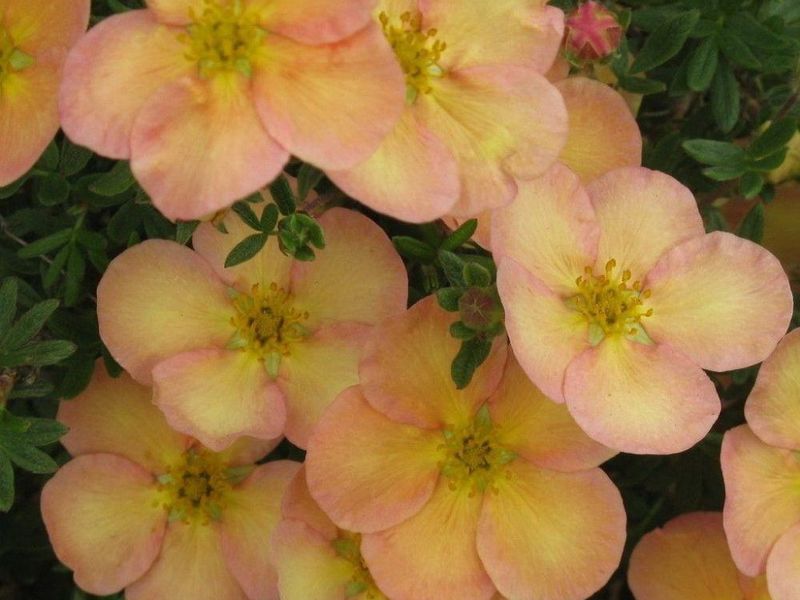

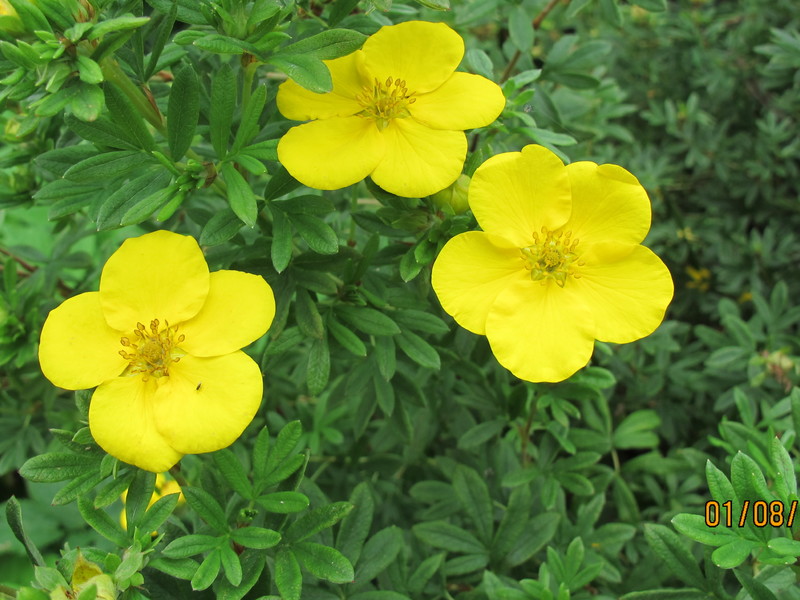
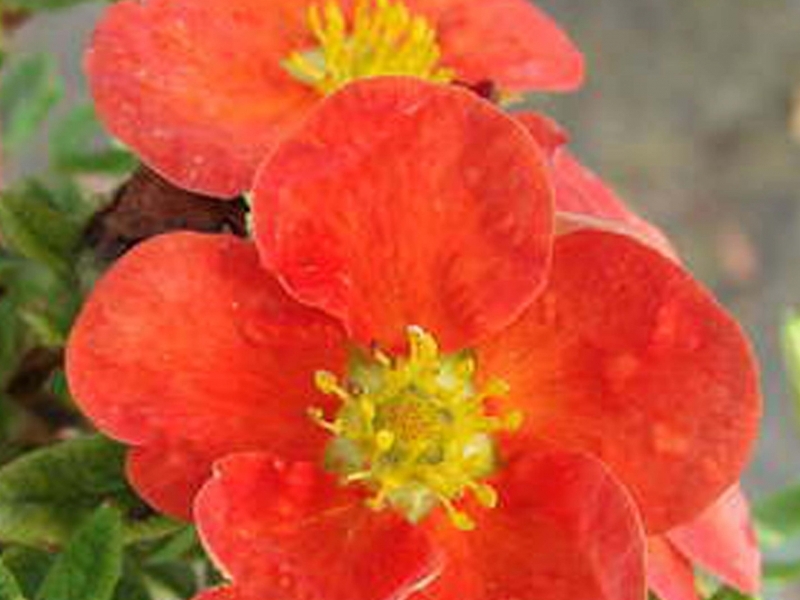
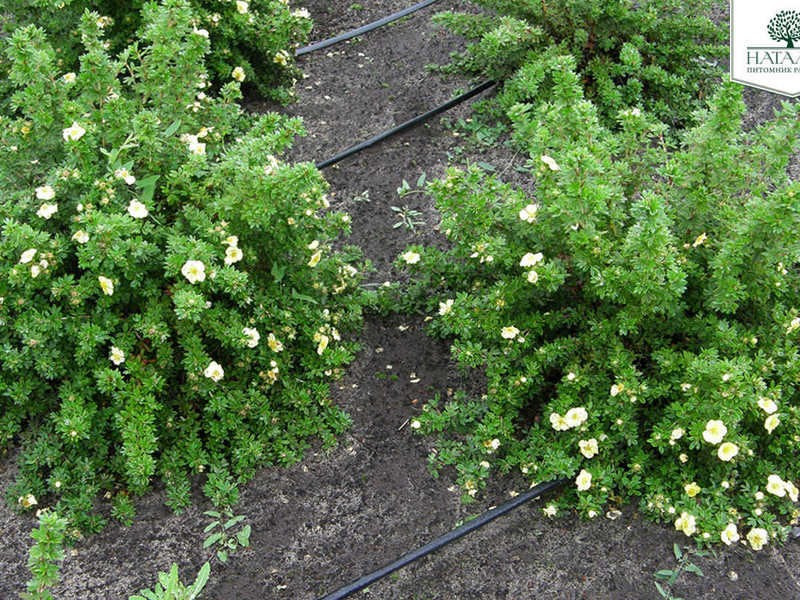


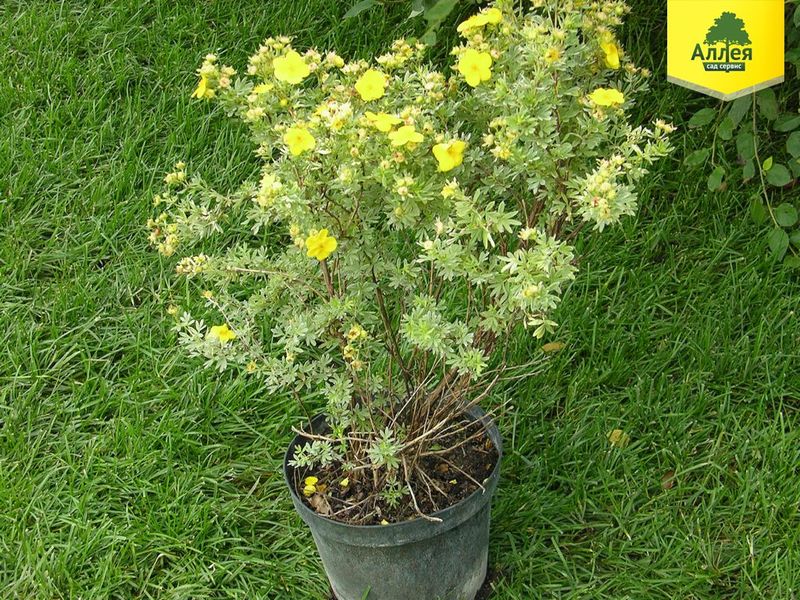
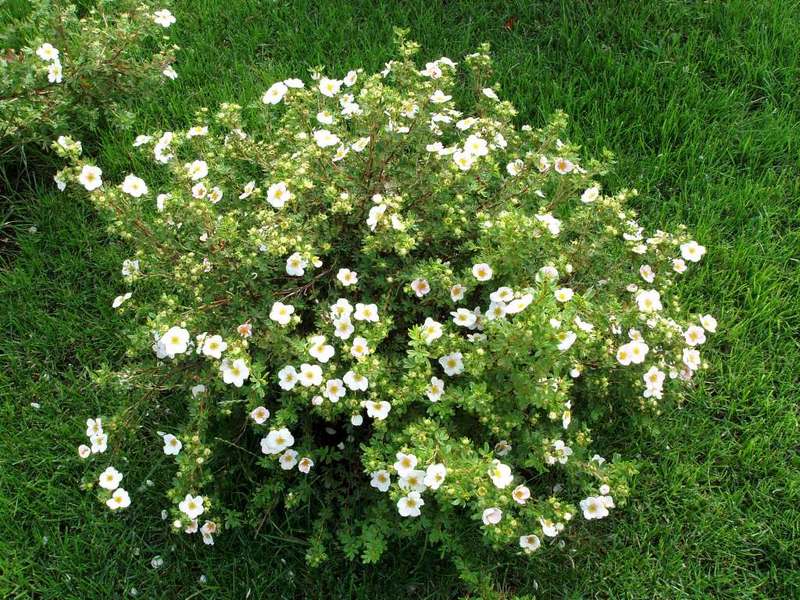
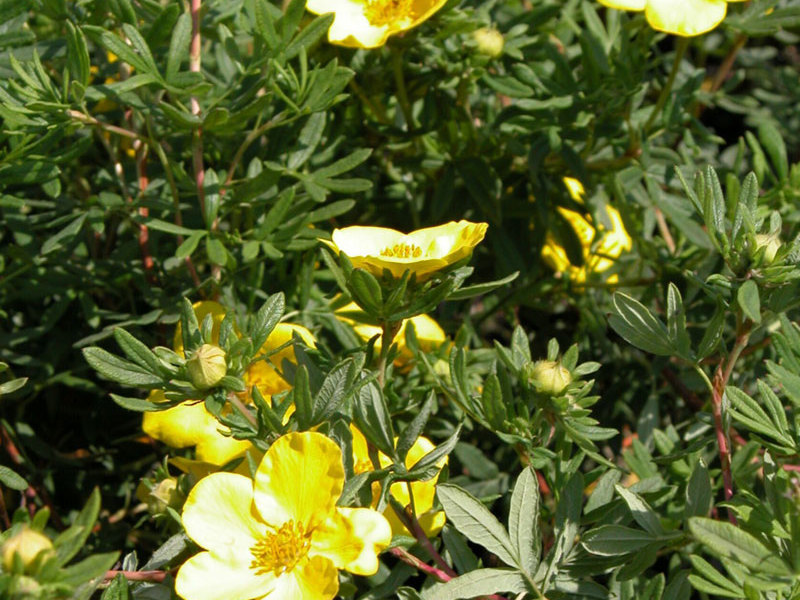
Varieties and varieties of Potentilla (with photo)
To date, more than 130 varieties of Potentilla are known, with photos and descriptions of some of them you can find in this section. Most of the ornamental varieties have green leaves, while the flowers retained the yellow color of their wild ancestors, but with a wide variety of shades. There are forms with white, pink, orange-red flowers.
Elizabeth is a shrub 0.8 m high, crown diameter up to 1.2 m, with a cushion-shaped crown, bluish-green leaves. This variety of Potentilla has light yellow flowers, up to 4 cm in diameter. The Elizabeth form blooms from June to October.
Farreri is a shrub 0.6 m high, crown diameter up to 1.3 m, cushion crown, gray-green leaves, dark yellow flowers, up to 3 cm in diameter, blooms from late June to August, abundantly.
Abbotswood is a shrub up to 1 m in height, with a crown diameter of 1.3 m, with a dense, cushion-shaped crown, flowering time from June to October.
As you can see in the photo, this variety of Potentilla has pure white flowers:
Varieties with yellow and dark yellow flowers: "Kobold", one of the lowest (height - about 0.6 m), with light yellow flowers. It grows faster than other varieties, therefore, in order to maintain the crown in a decorative state, it is recommended to regularly prune it.
Variety "Jackman" ("Jackman"), has light yellow flowers blooms in spring in May. The varieties "Goldfinger", "Sommerflor" and "Goldteppich" bloom profusely with large (up to 5 cm in diameter) yellow flowers from June to October.
The variety "Goldstar" ("Goldstar") also blooms for a long time. The height of the shrub is 0.8–1 m, the crown diameter is up to 1.2 m. Kuril tea of the Klondike variety, a shrub with a spreading crown up to 1.3 m in diameter and light yellow flowers, is winter-hardy.
Varieties with pink flowers: "PrettyPolly" and "Princess" - medium size (diameter - 3.5 cm).
Soft creeping shoots and orange-red flowers in the Red Ace variety.
The undersized Longacre variety, which blooms from June to September, is very beautiful when fully blooming. This plant has bluish green leaves and flowers with a yellow center.
The shortest type of Potentilla is Potentilla nitida: its height is barely 10 cm.
Look at the photo: in this type of Potentilla, the stems and leaves are covered with a silvery fluff:
Sufficiently large (up to 3 cm in diameter) pink flowers are rarely formed under artificial breeding conditions.
Cinquefoil (Potentilla anserina) is better known as goose feet. This hardy plant has beautiful feathery leaves and large yellow flowers that bloom throughout the summer. Goose foot is not only edible, but also a useful plant: there is a lot of vitamin C in young growth.
Golden Potentilla (Potentilla aurea) has 5-lobed leaves, pubescent at the edges, on long petioles and orange flowers with yellow edges, blooming in early summer. The species does not tolerate calcareous soil!
Drought-resistant cinquefoil (Potentilla arenaria) blooms from late April to summer with rather large yellow flowers.
Pay attention to the photo - this variety of Potentilla has creeping stems:
Plant height - 10-15 cm.
But, probably, the most typical representative of the genus is Potentilla fruticosa, or Pentaphylloides fruticosa. This type of Potentilla is a compact deciduous shrub up to 1.5 m high with highly branched stems covered with small, 5-lobed, pubescent leaves. Wide open, light yellow flowers are formed throughout the summer. True, flowering can hardly be called plentiful.
Culture care
For unpretentious cinquefoil, the most common care is required, including basic agricultural work.
Frequent and moderate watering, which does not allow stagnant water, is especially important for young seedlings. It is enough to irrigate the soil under them once every 7 days. Adult shrubs are watered less often - as the top layer of the soil dries out. The standard volume is 10 liters of water per bush.
Fertilization is carried out every spring. This requires mineral supplements of potassium and phosphorus. The procedure is carried out before flowering.
The soil under the young bushes is loosened and weeded if it is not mulched. Mulch in the form of peat is preferable because it excludes frequent loosening and prevents the appearance of fungus and harmful insects.
With constant stagnation of moisture at the roots, an overall disease-resistant plant can become sick.
To avoid this, it is important to regularly inspect the shrub and timely carry out preventive spring spraying with insecticidal and fungicidal agents.
Cropping of culture is carried out 1 time in 3 years in spring and autumn. For rejuvenation and for sanitary purposes, the branches are cut to 1/3 of their length.
At the same time, sick, damaged branches should be removed.
Preparation for wintering consists in cleansing the lower part of the trunk from leaves, then it is necessary to remove any plant residues and debris from the roots, and then cover the near-trunk space with peat to a height of 15 cm
A structure is created on top, on which a dense non-woven material or burlap is placed, a reliable shelter is especially important during severe snowless winters
Useful cultural features
 Kuril shrub tea includes about 3,000 species. The plant was given the name, which in translation from Latin means "strong", "mighty" for its useful and medicinal properties. At one time, Ilya Muromets breathed the aroma of such a plant and became stronger and stronger. In ancient times, all healers called such a plant a mighty one.
Kuril shrub tea includes about 3,000 species. The plant was given the name, which in translation from Latin means "strong", "mighty" for its useful and medicinal properties. At one time, Ilya Muromets breathed the aroma of such a plant and became stronger and stronger. In ancient times, all healers called such a plant a mighty one.
Cinquefoil can be used in the treatment of urinary incontinence in children, pyelonephritis and diabetes, as well as for the treatment of purulent wounds, the healing of burns and boils.
An infusion of Potentilla branches according to a folk recipe helps to cope with pain and severe cuts in the intestines, with dyspepsia, diarrhea with blood, acts as a hemostatic drug. The inhabitants of Tibet use this remedy for pneumonia as an expectorant.
Also, the roots of the bush have special healing properties, they are usually used for diarrhea. The infusion of the plant is used to eliminate stomatitis, purulent sore throat and other diseases of the oral cavity.
July is considered the most suitable month for creating such a drug, since it is during the flowering period that the plant begins to produce useful components.
The beautiful and graceful culture of shrub Potentilla is unpretentious in care and does not cause much trouble to the summer resident. Proper care and cultivation of such a healing shrub can bring pleasure to the summer resident, as well as special benefits for his health. The plant will perfectly decorate the landscape of the cottage during its flowering period.
Planting and leaving
Goldfinger shrub cinquefoil has its own preferences for living, so it is worth observing a little that will help the shrub to please its owner. The plant may be in the shade, but it is preferable to determine the planting site in the open sun. The roots are not located deep, although sometimes they can go into the ground up to 0.8 m.
A shrub is planted to a depth of half a meter. First, you need to drain the soil with a layer (0.2 m) of pebbles or chipped bricks. If the soil is not distinguished by an abundance of nutrients, feeding can be done artificially. When planted as a hedge, it is worth maintaining a distance between the bushes of 0.6 - 0.8 m.
Loves abundant watering, but firmly tolerates the dry period. Dry air has a negative effect on the plant. If the weather is hot, then watering is carried out 3-4 times per season, 1-1.5 buckets for each bush. Loves evening spraying, but you need to try not to damage the flowers. The younger the plant, the more often and more abundantly it should be watered. Loosen the soil to a depth of about 10 cm. Remove weeds. After planting, mulch with a layer of at least 5 cm.
Shrub pruning
It is enough to cut the shrub once every five years at the end of April. After pruning, stumps up to 20 cm long remain. The branches of the plant grow back quickly. Pruning is followed by mandatory feeding. Cardinal pruning is optional. It is enough to remove weak or old branches in the spring. Once every couple of years, you can trim the edges by 10 cm to create a more compact bush. Any circumcision takes place in the second half of April.
In September, you can shape the plant, cutting off 1/3 of the length of the shoot. Cinquefoil does not require special preparation for frost. The ends of annual shoots can be damaged in very severe frosts; if properly cared for, the plant becomes more resistant to cold winters with age.
Rust or powdery mildew can damage the leaves. Both are caused by fungi. Rust forms reddish spots on the leaves. Powdery mildew - light bloom. Fungi are parasites that feed on the host.
Cinquefoil, another name for Kuril tea, is a low flowering shrub.
Goldfinger Shrub Potentilla is an unpretentious, showy shrub used in hedging. The height of an adult bush reaches one meter and twenty to thirty centimeters.
Goldfinger blooms with dark yellow flowers, up to five centimeters in diameter.
This variety is not only decorative and beautifully blooming, but also winter hardy.
Shrubs are best planted in groups. Looks very good as hedges and curbs.
In nature, Potentilla grows in the forests of the Far East and South Siberia.
Goldfinger cinquefoil is simply the record holder for the longest flowering period.
Shrub Potentilla has many advantages in addition to decorativeness. This plant is long-lived, the lifespan of Potentilla is about twenty years.
Kuril tea does not need to be covered for the winter, it tolerates winter very well, and its frost resistance increases with age. In addition, the shrub is resistant to gas and smoke.
Cinquefoil goldfinger cultivation:
If the abundant flowering of Kuril tea is important for you, then plant it in a sunny place. In partial shade, the plant will grow, but it will bloom badly
Potentilla prefers soils moist, light and fertile. At a young age, cinquefoil must be protected from damping off.
Potentilla seedlings are best chosen with a closed root system. Then it will be possible to land at any time.
They plant a shrub like this: make a planting hole sixty to seventy centimeters deep, then pour drainage, after it a layer of fertile soil, and then plant Potentilla.
The Goldfinger variety requires the same care as all Potentilla shrubs. Every spring, the shrub should be pruned almost at the level of the soil. This stimulates the growth of young shoots.
In hot weather and in drought, Goldfinger, like other varieties, needs to be watered.
Shrub cinquefoil is a rather moisture-loving plant, so abundant watering is needed. In the spring, you need to carry out mineral dressing, and at the beginning of flowering, feed it with phosphorus-potassium fertilizers.
There are a lot of varieties of Potentilla, using only this plant, but different varieties, you can create unusual and original hedges. Different varieties of Potentilla bloom with flowers of different colors, but for all the flowering period lasts all summer.
See how to properly cut cinquefoil with Anna Tyatte (program: "Good advice"):
Trimming
It is very important to constantly monitor the number and length of young growth. If you do not cut the plant on time, then it begins to overgrow and look less aesthetically pleasing.
In addition, the lower part of the shrub may be exposed.
That is why in early spring, as well as in late autumn, at the end of the flowering period, a full-fledged pruning of the flower is carried out, in which the inside of the bush or dried branches are carefully removed. Every three to five years, the culture needs to be rejuvenated - a third of the shoots are cut to the soil level
Decorative pruning is also considered relevant, with the help of which the gardener can give the cinquefoil any desired shape.
Description
Cinquefoil is one of the varieties of herbaceous plants of the Rose family. Most often it can be found in the northern hemisphere in areas with a temperate climate.
To date, more than 300 varieties of Potentilla are known, but about 60-70 species and varieties are actively used in gardening. Thanks to numerous selection studies, gardeners managed to invent both annual and perennial versions of Potentilla.
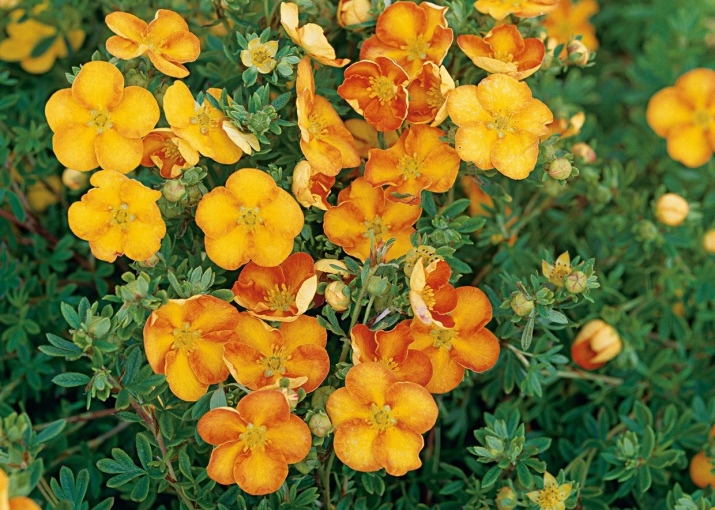
The appearance of these plants varies greatly depending on the particular variety.
- Stems are of a straight or creeping type with characteristic nodes on the stems, which, when in close contact with the soil, form a root system.
- The shape of the leaves, depending on the variety and type of plant, can be either trifoliate, pinnate, or fingerlike. In addition, stipules can often be found in Potentilla.
- The shade of the inflorescences of the classic Potentilla is lemon-yellow, however, there are varieties with pink, white, red and orange inflorescences.
- Flowers are usually arranged singly along the Potentilla bush, however, they can form full-fledged inflorescences of 5-6 flowers. The number of flowers per 1 bush of Potentilla varies depending on the age and variety of the plant - from 10 to 80 or more flowers. The shape of the flowers is round or saucer-shaped.
- The flowering period of these plants, depending on the variety, lasts from May to August, for 55-60 days. In the first year after planting in a new place, Potentilla usually does not bloom.
- The height of Potentilla varies greatly depending on its type. So, there are varieties with a maximum height of 25 to 90 cm. Regarding the structure of the crown, Potentilla can be either spreading or grow straight in height.
Growing and caring for Cinquefoil Kustarnikova
To grow a cinquefoil shrub, several important factors must be taken into account. Among them, almost all are associated with planting and growing a plant.
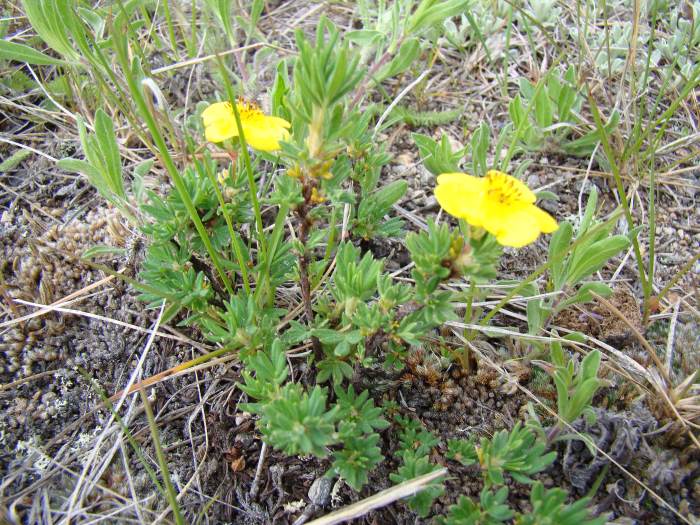
Selection of a seedling. In order for the Five-leafed Shrubbery to fully develop, it is recommended to give preference to buying in the spring. It is better to plant directly in open soil. For the acquisition of culture, give preference to nurseries. A bush should be chosen with several shoots, a miniature crown, since this means that the root system is sufficiently developed. The roots should not be broken, short or dry (optimally - from 15 centimeters). You cannot choose a seedling during the flowering period, since a sharp change in growing conditions will lead to negative consequences.
Choosing a landing site. Shrub Kuril tea does not like to be under the influence of ultraviolet rays for a long time, but even with a lack of sunlight, its flowering is scarce. Therefore, it is best to choose a shaded area for it, which will be well lit in the morning and evening. In open spaces, you can get a more lush shrub with even flowering.
Another important rule is not to plant a plant next to conifers, as this can lead to infection with various diseases.
Priming. Planting of Lapchatka Kustarnikova is carried out in the spring in a fertile slightly acidic soil with good air permeability
For comfortable growing conditions, mix the leafy soil with peat and sand in a ratio of 2 to 2 to 1. You can also add lime in granules.
After half an hour, you can spill the surface of the soil with a liquid humic dressing to stimulate growth. A layer of mulch is laid on top, consisting of straw, sawdust and peat. The layer thickness is 5 centimeters.
When planning to create a hedge, make the distance between the bushes of Kuril tea 40 centimeters, and directly between the rows - 30 centimeters. To avoid the formation of "voids", plant the shrubs of the Five-leafed Shrub in a checkerboard pattern.
Proper care of the shrub Cinquefoil or Pentaprox
To get beautiful and lush Kuril tea bushes, it is necessary to provide them with proper care.

- Watering. Periodically, the culture needs soil moistening. This should be done as the soil dries out. For each bush, you will need to add 10-12 liters of water. The frequency of this process is once every 7 days. The shrub also responds well to spraying the leaves. This procedure is carried out up to 2 times a week. If mulching was previously performed, then much less water can be used. It is recommended to finish the irrigation procedure in mid-September.
- Fertilizers. It is recommended to feed Kuril tea 4 times per season. Usually this procedure falls in April, June, July, August. For such purposes, several options for feeding are used. For example, a mullein solution diluted in water - 1 to 10. Frequency rate - 3 times a month. You can also use an ash solution (for 5 liters of water, 300 g of the substance is used). This procedure is carried out 2 times a month.
- Weeding. Five-leaf shrub loves loosening, therefore it is recommended to saturate the soil with air 1-2 times every 7 days, the depth of weeding is up to 3 centimeters. It is best to carry out this procedure half an hour after moisturizing. Do not forget to remove weeds, check bushes for pests and diseases.
Bushes that are more than 10 years old should be rejuvenated, old branches removed up to 1/3 of their length. Once every 10 years, shrubs are cut under a stump, leaving only 10 centimeters from the ground.
Despite the fact that most of the varieties of the bush are considered frost-resistant, it is still better to play it safe and build a frame for shelter. This is needed not so much for protection from cold weather, but also to keep the bush from being damaged by the weight of the snow.
Mulching can be done to protect the root system. The soil around the crop is covered with peat or dry straw, the layer thickness is 10 centimeters.
Pest control
The most common pest of Kuril tea is the caterpillar.It damages the leaves of the bush, can lay eggs on the plates of the leaves. This leads to inhibition of development, a deterioration in its condition. To combat insects, the preparations "Actellik" and "Oberton" are used.
Also, plants can be damaged by a fungal disease - rust. For treatment, use a solution of boron or manganese (5%). As a preventive measure, it is recommended not to plant crops near conifers, as they can infect the plant.
Conclusion
Nepalese cinquefoil is a very unpretentious perennial flowering plant that will be a welcome guest on almost any site. It gets along well with any flowers, and it may well act as a soloist, decorating a flower bed or a border.


